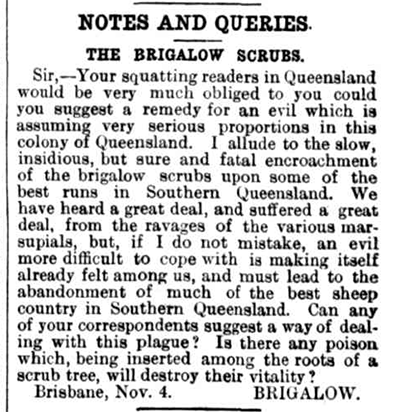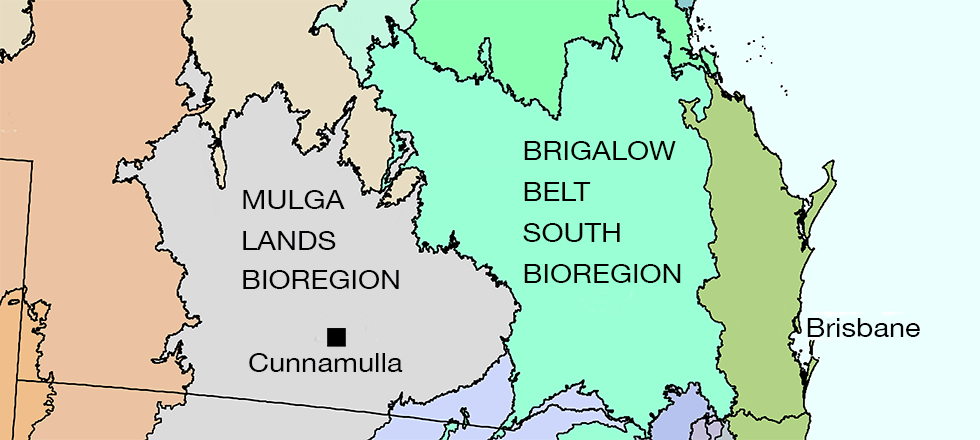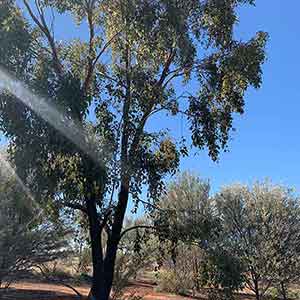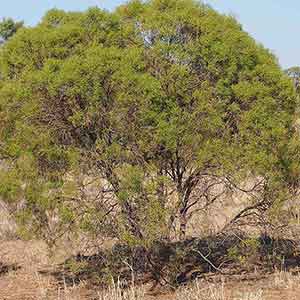the neighbouring bioregion

To understand the significance of Brigalow (Acacia harpophylla) for the regions around Cunnamulla it's valuable to look at the bioregion map. This shows how the Brigalow Belt South Bioregion is located adjacent to the Mulga Lands Bioregion which is home to the Warrego and Paroo river catchments.
Briglalow is hence at the western limit of its distribution when it crops up here east of Cunnamulla. It especially thrives in the blacksoil plains while also doing fairly well in the soft red soils. This is the same country that gidgee likes to own around here and the two species can overlap and interact in the battle to control this fertile ground.
This means that many of the characteristics we associate with gidgee woodland apply also to brigalow communities. Secondary woody plants like wilga for example are common to both settings and you can find wilga planted here in this precinct.
the brigalow story

Brigalow's habit of growing in some of the finest farming soils on offer in Australia has long been a challenge for agricultural enterprise in Queensland.
As this article from November 1878 clearly shows, brigalow regrowth was from the outset seen by some as a plague needing a ready solution.
Initially, the task of turning the brigalow into a breadbasket turned out to be more challenging than the settlers expected. Brigalow trees have a well-developed lateral root system. If the tree or roots are damaged, dense suckers spring up. This growth stage can last for 20-30 years and is followed by a whipstick stage lasting another 20-30 years before mature forest is formed.
This habit made permanent removal very difficult, as suckers can occur at a density of 20,000 stems per hectare and it was not until the 1960s that broad acre clearing really got underway on a grand scale.
As a result, of the animal species that formerly occupied the Brigalow Belt, several are now totally extinct. These include the Paradise Parrot, White-footed Rabbit-rat, Brush-tailed Bettong and the Darling Downs Hopping-mouse. A number of other animal species are now regionally extinct, for example the Bilby, Eastern Quoll and Long-nosed Bandicoot.
The same situation also applies to native flora. Many of the brigalow remnants on which native species now depend are marginal habitats such as steep, rocky slopes or are in poor condition and highly degraded.
Where tree and shrub cover are much reduced, there is a high incidence of weeds and feral animals which either further ruin the landscape (digging by rabbits, for example) or prey upon native animals. Over-grazing, soil erosion, raised water tables and salinity further reduce the quality of the remaining habitats.
Federal action in response to this situation has been to develop and implement recovery plans for the nationally threatened species in the Brigalow Belt. Ecological communities can also be listed under the Commonwealth Environment Protection and Biodiversity Conservation Act and a number of Brigalow communities have been nominated for Commonwealth listing.
If listed they will have recovery plans developed and implemented. It is vital to ensure that significant and large brigalow remnants are included in conservation reserves before they, too, are seriously fragmented.








